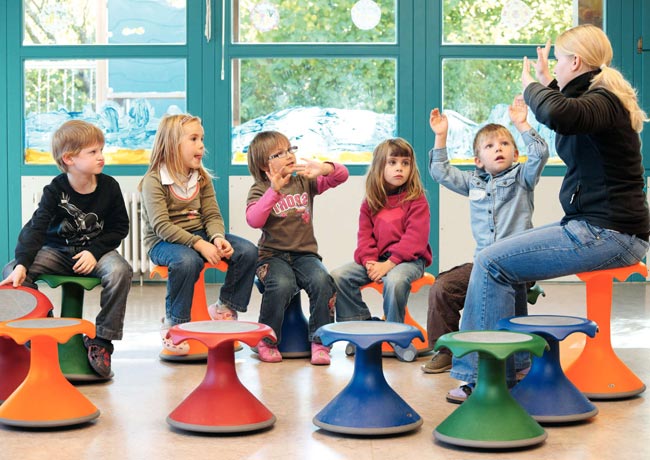Sitting still in class is a challenge. Active Seating is the solution.
Traditional classroom seating is rigid, static and restrictive when it comes to allowing movement and, for some students, sitting still for hours on end is a real challenge.
For these students–some of which may have learning disabilities such as attention deficit disorder (ADD), attention-deficit/hyperactivity disorder (ADHD), or even sensory perception disorders–having the ability to move about freely is critically important when it comes to being able to focus on classroom work.
Yet, many schools still aim to tame student’s physical movements, rather than incorporate them into the learning process. For students who need to fidget to focus, this sort of restrictive nature can curtail their overall learning potential.
Fortunately, many schools around the country are radically changing their approach to classroom design to include active seating, which encourages movement and allows fidgety students to focus on the lesson, rather than the challenge of sitting still.
Active sitting, also known as dynamic sitting, is seating that naturally encourages us to stay in motion, rather than passively relaxing into a slouch or attempt to rigidly hold a “correct” pose.
The Furniture Industry Research Association argues that, unlike traditional classroom seating, active seating, “accommodates natural movements and boasts a range of benefits including better spinal positions, muscle stimulation, blood circulation, and neurochemical processes that promote concentration.”
Students will find a way to move around regardless of the type of chair they’re sitting in. Because traditional school seating lacks the flexibility of active sitting, students often resort to creating their own movement by leaning the chair back on two legs and frequently shifting their position on the chair. Forced movement such as this can lead to tight muscles, soreness or even physical injury.
Active seating is fidget-friendly, so, for children who squirm in their seats and can’t resist the impulse to move, it’s a way to channel their excess energy into constructive activities. Active seating acknowledges a child’s need to move, but at the same time, keeps them sitting still enough so that teachers and other students may continue lessons uninterrupted.
This is in contrast to forward-facing and rigid seating, which can result in poor attention, poor memory and ultimately, lower achievement scores. In turn, this has an impact on teachers, principals and administrators, who have to have to spend extra time and resources to keep these students engaged in class.
In today’s fast paced world of iPads, instant gratification and continuously narrowing attention spans, keeping a child engaged and sitting still in class can be a considerable task. For children with ADD, ADHD, autism spectrum disorder or other learning disabilities, it can be even more difficult to stay engaged. Many of these students have a “constant need for movement-based sensory input, which is why many students are fidgeting, slouching or even chewing on pencils.”
Active seating can really make all the difference in this regard. Unlike traditionally rigid and restrictive school seating, active seating encourages student movement and incorporates it into the learning process. It gives students who need to move a better chance at success in school because they don’t have to constantly fight the restrictive nature of their chair. Instead, they can use their chair’s flexibility to their advantage.
Analysis:
In my experience as a nanny and at-home tutor during the COVID-19 pandemic, I have seen first-hand how difficult it is for elementary school students to focus and stay engaged in the virtual classroom environment. With already low attention spans, children in online education are required to dedicate extensive amounts of time sitting in front of a screen to absorb knowledge. In addition, teachers no longer have the same control over their students’ environments. While this article highlights a solution to fidgety students in a classroom setting, its arguments could also be applicable to online learning. The idea of incorporating movement into a traditionally static atmosphere seems contradictory at first. However, allowing children to channel their restlessness into an object rather than their school work is incredibly interesting to me. How can the many benefits of active seating be applied to the uncontrollable nature of the at-home setting?




